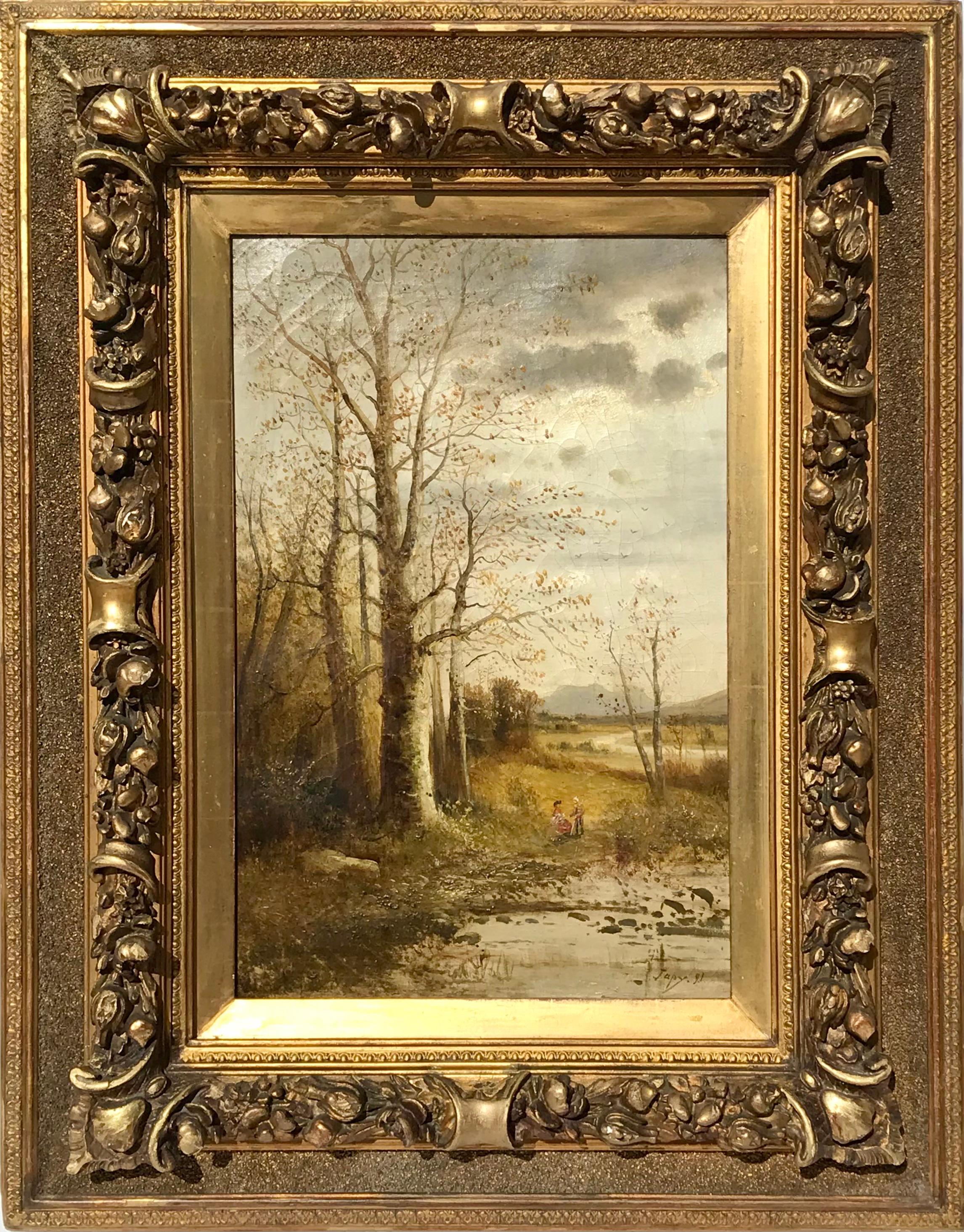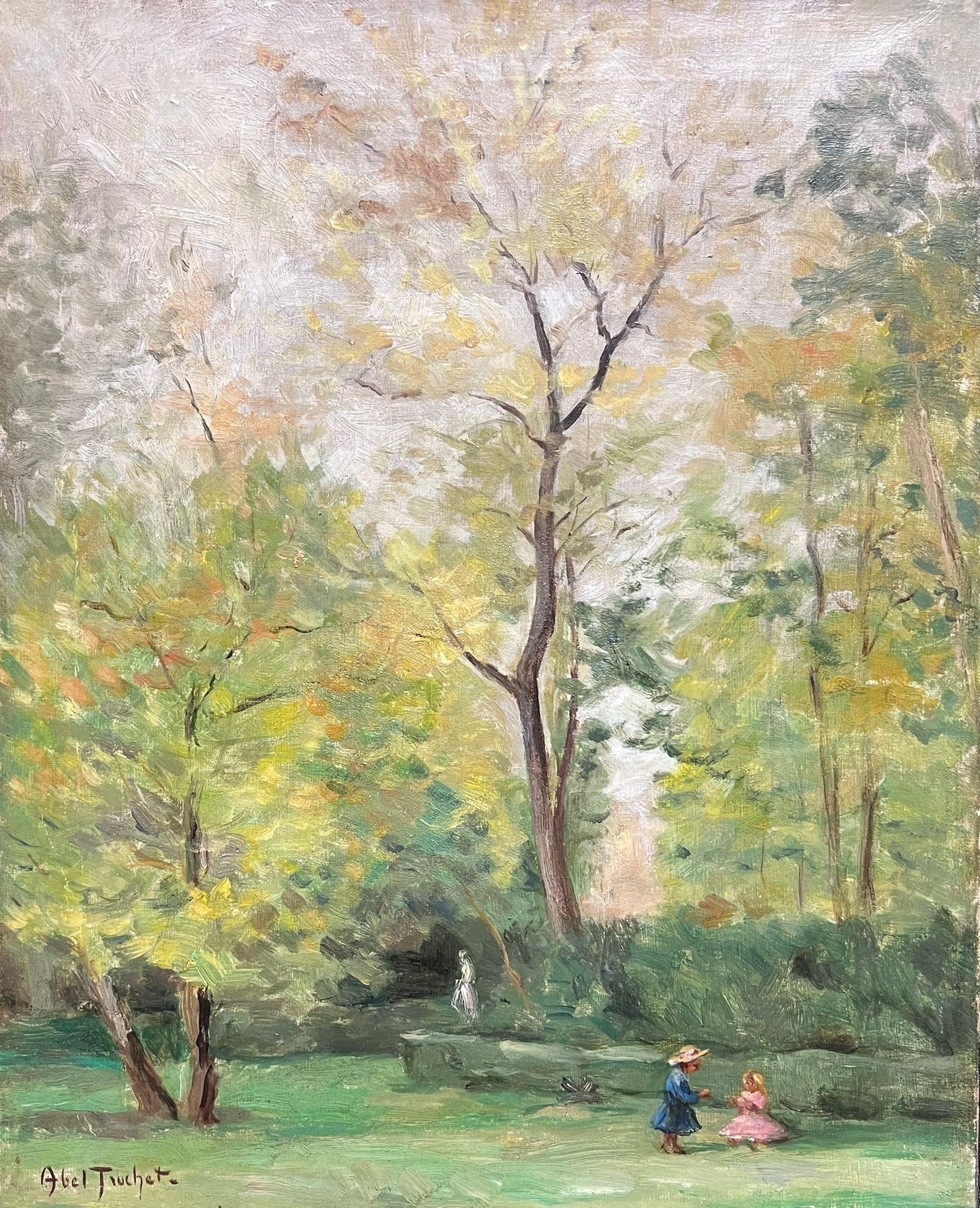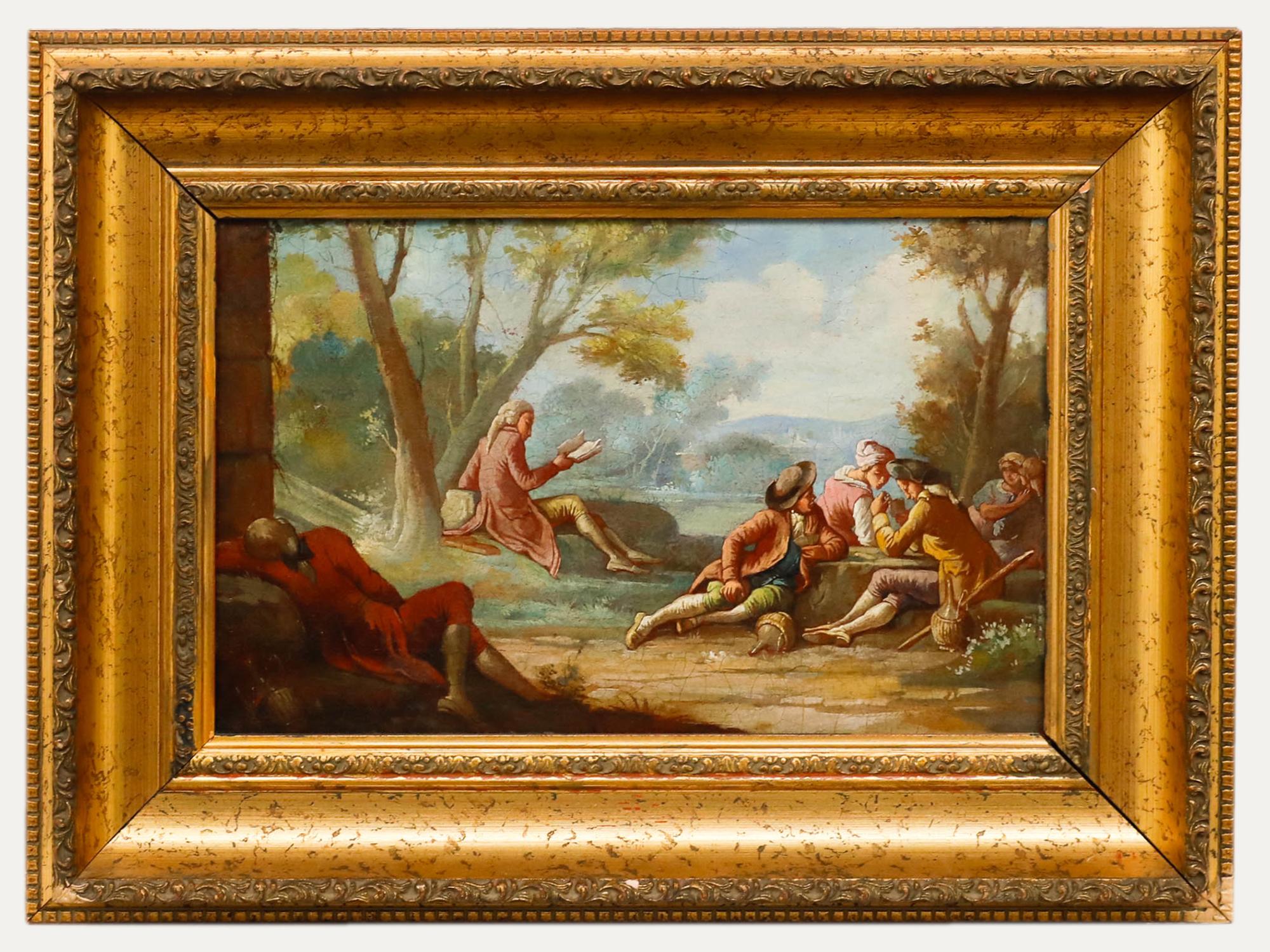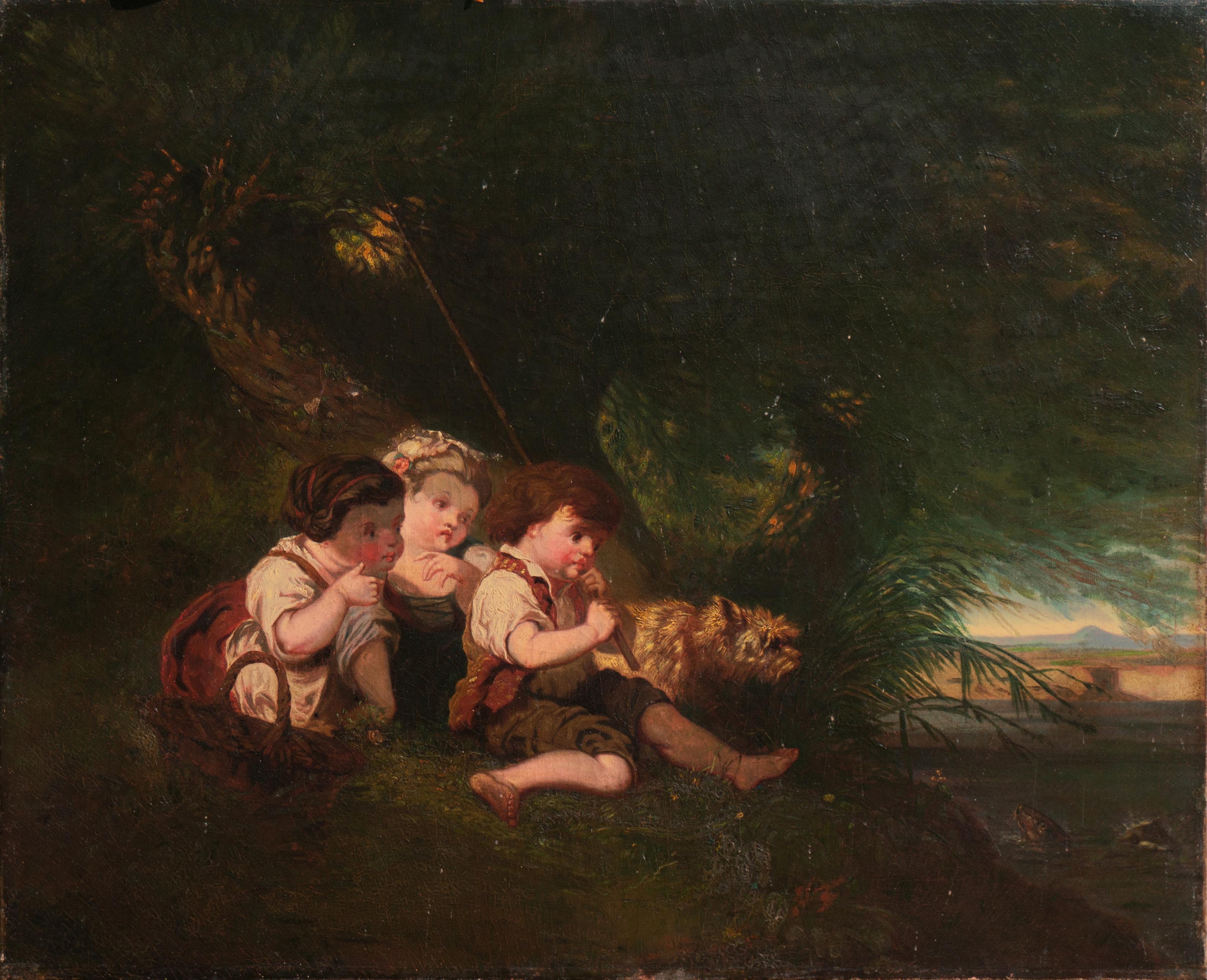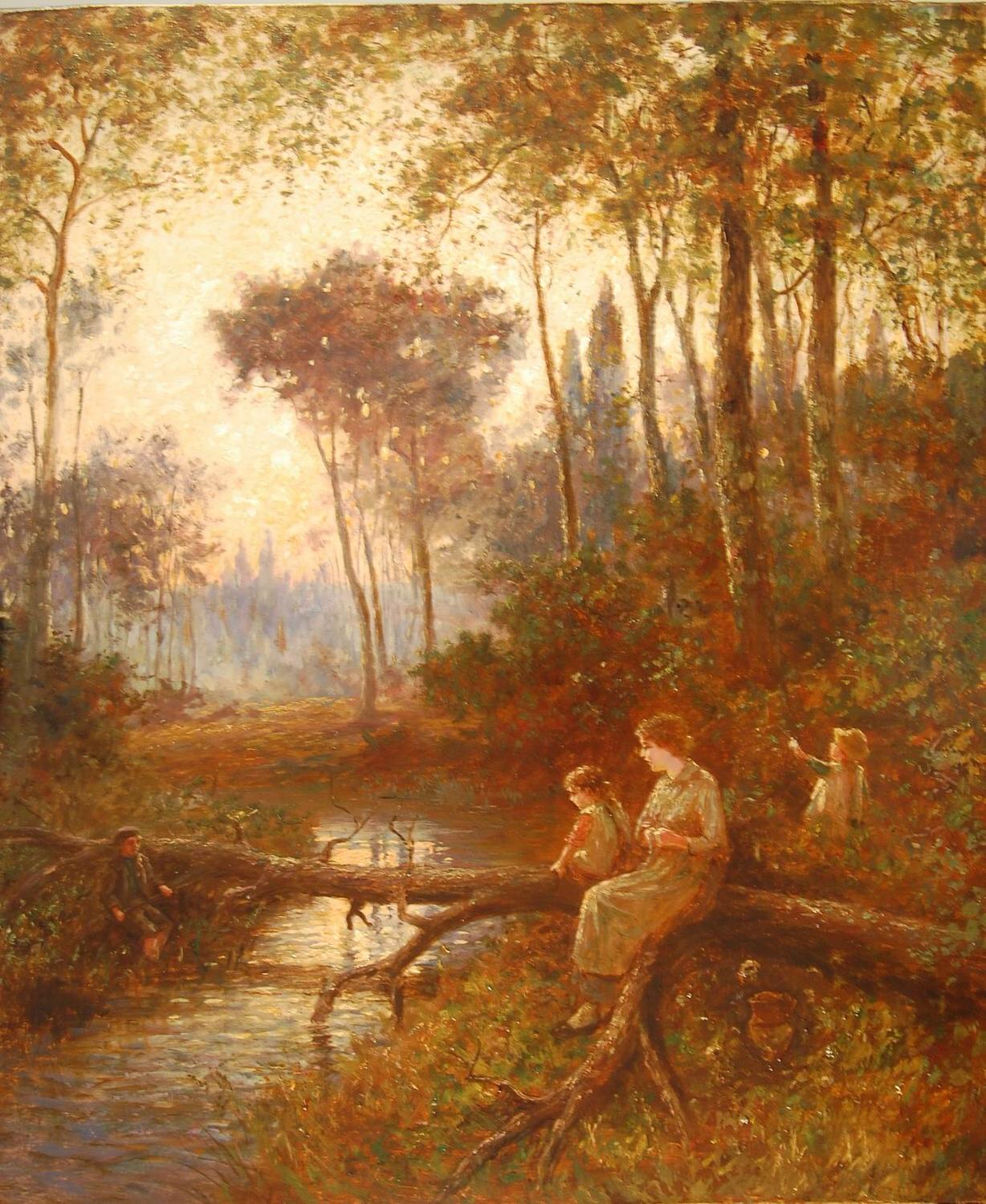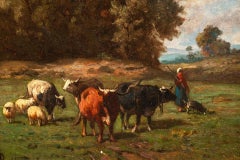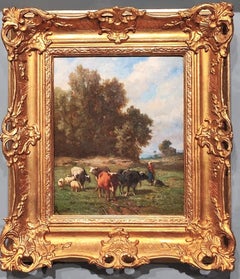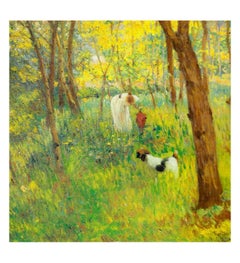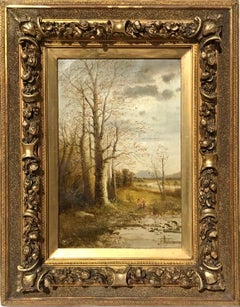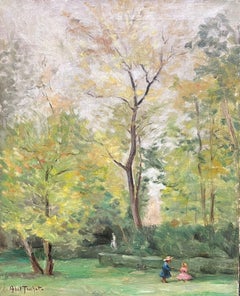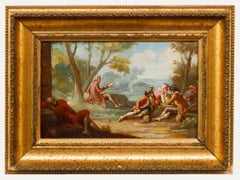Items Similar to Children playing in a forest
Want more images or videos?
Request additional images or videos from the seller
1 of 9
Amédée Elié Servin — (1829-1884)Children playing in a forest
$10,351.48
£7,689.42
€8,650
CA$14,280.59
A$15,698.30
CHF 8,250.30
MX$190,634.50
NOK 102,920.48
SEK 97,509.91
DKK 65,848.28
About the Item
Amédée Elié Servin — (1829-1884) : Children playing in a forest
A nice and confidently painted scene of three children playing in the midst of a dark forest. Through clever use of colour and light and dark effects, Elié Servin creates a mysterious and fairytale-like scene in which all attention is drawn to the playing children.
Amédée-Élie Servin (1829-1884)
Servin Amédée-Élie was a French painter and engraver, founder of the artistic community of Villiers-sur-Morin.
Servin was born to a tanner, who, disappointed by his son's failure in his studies, apprenticed him to an upholsterer where he learned to draw cartoons. He then entered the École des Beaux-Arts and studied under the painter Michel Martin Drolling. At this school, he befriended students of his generation, such as Jean-Jacques Henner, Benjamin Ulmann and Paul Baudry.
He made his debut at the Paris Salon in 1850, presenting a courtyard interior; thereafter, he exhibited regularly. In 1855, he exhibited three landscape paintings inspired by Normandy and the following year, he was inspired by landscapes of Brittany. He was in contact with the first generation of painters who frequented Barbizon, where he met Théodore Rousseau and Jean-François Millet.
Around 1857, he settled in Villiers-sur-Morin, and in 1860, he founded the "artistic circle of Villiers", and persuaded other artists and writers to come to this village. He began to produce landscapes inspired by this Seine-et-Marne village, where he remained until his death.
In 1872, he received a medal at the Salon, one year after losing his wife. His widowhood made him sad, his production decreased.
His friend Alexandre Falguière sculpted a bust of him for a monument erected in his honour in Villiers in 1888. Servin was nicknamed the "master of the Morin valley".
Benezit cites this pupil of Drolling as an artist of great sincerity, without commercial preoccupation, whose works deserve to be sought after by connoisseurs.
- Creator:Amédée Elié Servin — (1829-1884) (1829 - 1884, French)
- Dimensions:Height: 36.23 in (92 cm)Width: 48.04 in (122 cm)
- Medium:
- Movement & Style:
- Period:
- Condition:
- Gallery Location:Gent, BE
- Reference Number:1stDibs: LU2140211008452
About the Seller
5.0
Vetted Professional Seller
Every seller passes strict standards for authenticity and reliability
Established in 2018
1stDibs seller since 2022
5 sales on 1stDibs
Typical response time: 2 hours
- ShippingRetrieving quote...Shipping from: Gent, Belgium
- Return Policy
Authenticity Guarantee
In the unlikely event there’s an issue with an item’s authenticity, contact us within 1 year for a full refund. DetailsMoney-Back Guarantee
If your item is not as described, is damaged in transit, or does not arrive, contact us within 7 days for a full refund. Details24-Hour Cancellation
You have a 24-hour grace period in which to reconsider your purchase, with no questions asked.Vetted Professional Sellers
Our world-class sellers must adhere to strict standards for service and quality, maintaining the integrity of our listings.Price-Match Guarantee
If you find that a seller listed the same item for a lower price elsewhere, we’ll match it.Trusted Global Delivery
Our best-in-class carrier network provides specialized shipping options worldwide, including custom delivery.More From This Seller
View AllShepherdess at the edge of the forest oil on canvas by Louis Robbe
Located in Gent, VOV
"Robbe Louis, outdoor animal painter
ROBBE Louis Born in Courtrai on November 17, 1806, died in Brussels on May 2, 1887. Student of Eugène Verboeckchoven and Jean-Baptiste De Jonghe....
Category
19th Century Landscape Paintings
Materials
Canvas, Oil
Shepherdess at the edge of the forest
Located in Gent, VOV
"Robbe Louis, “Plein air” Animal Painter"
ROBBE Louis Born in Courtrai on November 17, 1806, died in Brussels on May 2, 1887. Pupil of Eugène Verboeckchoven and Jean-Baptiste De Jonghe...
Category
Mid-19th Century Barbizon School Landscape Paintings
Materials
Canvas, Oil
$4,936 Sale Price
25% Off
Picking Flowers By F.f. Koch
Located in Gent, VOV
"Picking Flowers By F.f. Koch"
Picking Flowers by Fréderic Ferdinand Koch (signed lower right) Provenance: Galerie Berko Was a painter and pastellist of figures, compositions, still...
Category
Late 19th Century Academic Figurative Paintings
Materials
Oil
French landscape painting by Paul Sébilleau (1847-1907), oil on canvas+ "Spring
Located in Gent, VOV
Serene beauty of the French countryside with this exquisite oil on canvas by Paul Sébilleau (1847-1907), titled "Spring Evening May 1901." This captivating french landscape painting ...
Category
Early 20th Century Realist Landscape Paintings
Materials
Oil
Washerwomen by the river, oil on canvas by Karl Girardet
Located in Gent, VOV
This painting is part of a series of paintings Girardet made of washerwomen by the river. Upon their presentation they had a considerable success, which endures till now. In 2008 another painting of this series was sold at Christie's .
Karl Girardet was born in 1813 in Le Locle, which at the time was part of France but is now part of Switzerland. Girardet lived and worked most of his life in Paris. After beginning his career as a painter of landscapes, he became a well-known history painter. As a confidant of the French king Louis Philippe I...
Category
Late 19th Century Realist Figurative Paintings
Materials
Oil, Canvas, ABS
On the banks of the Meuse near Waulsort by François Roffiaen (1820-1898)
Located in Gent, VOV
On the banks of the Meuse, near Waulsort (before the canalization of the Meuse)
Signed lower right
François Roffiaen (1820-1898): A Life in Brushstrokes
His kin, born from humble s...
Category
19th Century Landscape Paintings
Materials
Oil
You May Also Like
Courtship in the Forest French Romantic School XIX century oil on canvas
Located in Barcelona, Barcelona
Title: *Courtship in the Forest*
Author: French Romantic School
Technique: Oil on canvas
Support: Canvas mounted on a stretcher
Unframed dimensions: 11.4 x 7.9 inches
Frame...
Category
Late 19th Century Romantic Figurative Paintings
Materials
Canvas, Oil
$658 Sale Price
52% Off
Louis Aime Japy Figures in a wooded Landscape
By Louis Aimé Japy
Located in Dallas, TX
Louis Aime Japy (1840 - 1916)
Oil on canvas
Circa 1875
Signed lower right “Japy 91”
Measures: Canvas. 19 x 12.5 Inches
Framed: 29 x 23 inches
The scene is of a landscape with fig...
Category
1870s Barbizon School Landscape Paintings
Materials
Canvas, Oil
Signed Antique French Impressionist Oil Painting Children Playing in Park
By Louis Abel-Truchet
Located in Cirencester, Gloucestershire
In the Park
by Louis Abel-Truchet (French 1857-1918) *see below
signed oil on canvas, unframed
canvas: 16 x 13 inches
provenance: private collection, France
condition: overall good a...
Category
Late 19th Century Impressionist Landscape Paintings
Materials
Oil, Canvas
French School 19th Century Oil - A Day in the Park
Located in Corsham, GB
A charming French school scene depicting figures in 18th-century dress lounging in a sunlit park. Unsigned. Presented in a gilt frame with acanthus detail. On canvas.
Category
19th Century Figurative Paintings
Materials
Oil
'Children Landing a Catfish', 19th Century American School, Large Nocturnal Oil
Located in Santa Cruz, CA
A substantial, mid-to-late 19th century American School nocturnal landscape showing a view of three children, accompanied by their terrier, fishing by lamp-light and startled by the ...
Category
Late 19th Century Romantic Landscape Paintings
Materials
Canvas, Oil
Victorian Landscape and Figurative Oil of Children and Mother in River Landscape
By Ernest Walbourn
Located in ludlow, GB
Victorian Landscape and Figurative Oil painting on Canvas of Children and Mother in River Landscape.
Beautiful typically Victorian Family Scene.
Oil on Canvas by Ernest Walbourn (1872 - 1927) mounted on stretchers and signed on the reverse, framed in a traditional gold frame. Walbourn, who along with his wife Eva, was a 19th Century genre painter. It is said that his wife often did the backgrounds and he painted the figures. Certainly she is more known for her florals pictures...
Category
19th Century Victorian Figurative Paintings
Materials
Oil
More Ways To Browse
Paintings Children Playing
Jean Francois Millet
Oil Painting Children Playing
Alexandre Falguiere
Theodore Millet
Jean Jacques Henner
Paul Baudry
Jean Jacques Henner Oil Painting
Violin Art
God Painting
Spanish Bull
Vintage Pulps
Antique Flemish Frame
Bathing Art
Swimmer Painting
Framed Sketch Art
Haiti Art
Nude Italian Artist
